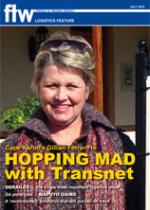Property developer Inframax
Holdings, although Cape-based,
operates nationally, and is
currently busy with an initiative aimed
at making the country’s major inland
port a ‘next generation’ one that will
service the entire country by “putting
Gauteng’s entire logistics capability
into a new and far more efficient era
and creating thousands of jobs, while
at the same time stimulating the area’s
GDP,” said Inframax MD Dr Willie Els
in SA Property News.
Using a 630-hectare tract of land
lying about 25 kilometres southeast
of the Johannesburg CBD, which the
company has owned for several years,
it is proposed that the new facility, to
be named Tambo Springs, will increase
Gauteng’s current freight logistics
throughput to 3-million TEUs by 2015
and 4-million TEUs by 2020 – with
further increases after that.
Tambo Springs, which will have
direct access to the N3 freeway from
Gauteng to Durban, the N1 to Cape
Town and the route via the R390 to
Port Elizabeth and East London, is well
situated for the freeways giving access
from Gauteng to key industrial centres
between 20 and 60 kilometres away,
such as Vereeniging, Vanderbijlpark,
Heidelberg and Sasolburg. Its handy
location 22 kilometres from City Deep
and 25 kilometres from the freight
terminal at Johannesburg’s OR Tambo
airport is likely to mean that the site
will be able to handle both longdistance
road freight, where trucks
are usually full, and part-load regional
distribution.
Of course this sort of capitalintensive
facility is all well and good
if there is sufficient transport volume
to use it. Whether road or rail, an
inefficient or inadequate vehicle or rail
truck pool frustrates any attempt, no
matter how well planned, to achieve
optimum flexibility and to be prepared
for unforeseen eventualities or sudden
changes of plan. Relatively quick
times for short and medium-distance
journeys are counterbalanced by long,
enforced and frustrating idle time in
traffic jams, while legal restrictioans
and over-zealous, sometimes corrupt
traffic officials with an acquisitive view
of law enforcement do little to expedite
matters. And there are always the
unforeseeable effects of weather to be
taken into account.
Els doesn’t think the freight
logistics needs of Johannesburg and
the surrounding areas have been fully
understood, particularly by the publicsector
authorities whose remit it is to
serve the area. “As a result, there is
excessive use and wear of roads by
freight operators; a dramatic decline in
rail usage which is largely due to poor
service levels; increased congestion
and fragmented freight planning. South
Africa’s freight logistics system is not
meeting the country’s needs, and it is
not keeping up with the way the world
is moving,” he says.
Tambo Springs dry port heralds new logistics era for Gauteng
16 Jul 2010 - by Staff reporter
0 Comments
Logistics 2010

16 Jul 2010
16 Jul 2010
16 Jul 2010
16 Jul 2010
16 Jul 2010
16 Jul 2010
16 Jul 2010
16 Jul 2010
